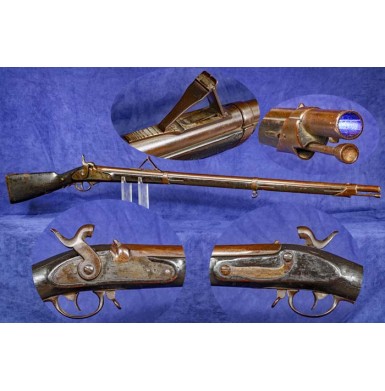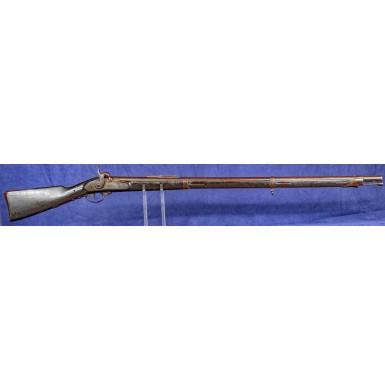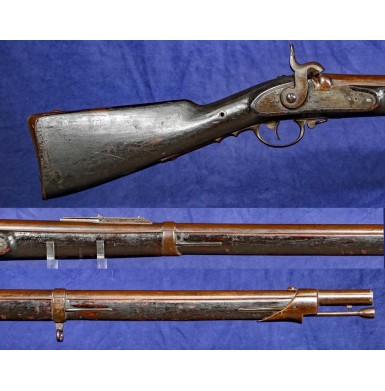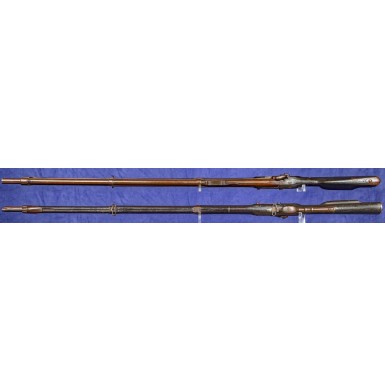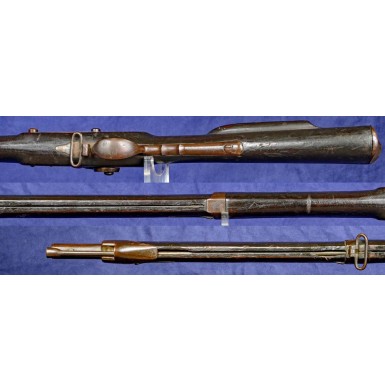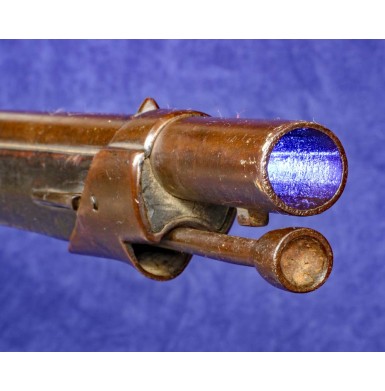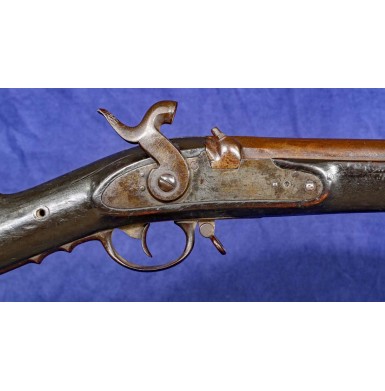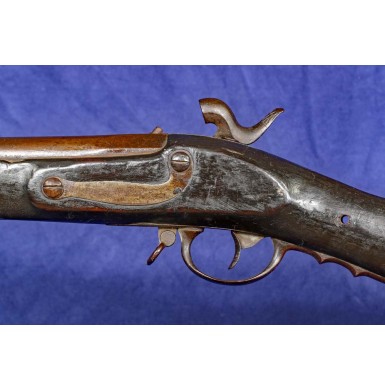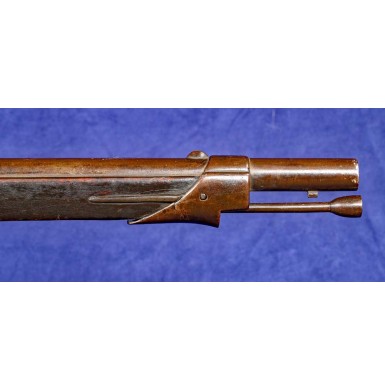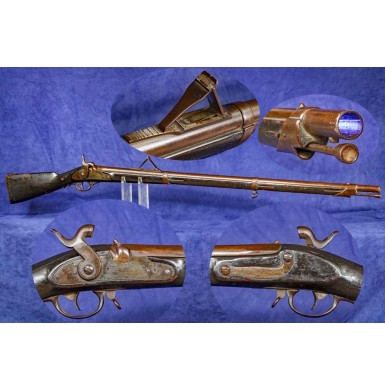Bavarian M1842/51 Rifled & Sighted Musket
- Product Code: FLA-3461-SOLD
- Availability: Out Of Stock
-
$1.00
This is one of the least often encountered continental arms imported during the course of the American Civil War and for year has presented quite a conundrum for Civil War arms collectors and import arms enthusiasts. The gun has been known to collectors as the Bavarian Model 1842 musket but more recent scholarship on the subject, recently published by my friend in Germany, Marc Schwalm, in his book European Arms In The Civil War indicates that the more accurate designation for the musket is the Model 1842/51.
The Model 1842 Musket was the first standardized percussion ignition musket used in the state of Bavaria. The Bavarian M1842 was a muzzleloading percussion ignition musket with a nominally 17.8mm (.70 caliber) smoothbore and a nominally 41 1/8” (104.5cm) round iron barrel with a short octagonal breech section. The barrel was secured by three flat, spring-retained iron barrel bands, a vertical screw through the breech tang and horizontal screw that also served as the rear lock bolt. All other mountings were of iron as well. The full-length stock, long thought to be of walnut, is noted as being cherry in Mr. Schwalm’s book. The stock had a flat forend as found on Austrian military muskets from the first half of the 19th-century and a raised cheek rest was included on the reverse of the buttstock. During the 1850s Bavaria began to experiment with rifled bores and held trials for various muzzleloading rifled systems, including that of Mini” and the Thouvenin system as well. As such, some experimentation took place with rifling systems, rear sights, etc. According to the newly published research, 1,000 of the Bavarian M1842 pattern muskets were made up with a folding ladder rear sight sometimes referred to as the “elbow sight”. These guns were also rifled with five lands and grooves; interesting as all other rifled M1842s received four lands and grooves. It has long been hypothesized that these scarce folding rear sight Bavarian M1842 muskets were produced in Belgium, but as noted my Mr. Schwalm and my own observations of extant examples, none are known with the legally required Belgian proof marks. Thus Mr. Schwalm suggests that these 1,000 trials guns were made up by an unknown Bavarian contractor, but were definitely not produced at the Amberg arsenal, as any such arms would have been marked “Amberg” on their locks. These altered arms, once rifled, were nominally 18mm, or .708”, the same as most large caliber French rifled arms of the period as well as the British Pattern 1851 Mini” Rifle. It is worth noting that all of the “Bavarian” M1842 rifled muskets encountered in America feature this unique folding long-range leaf sight rear sight. All such arms have unmarked locks, and the Bavarian M1842s with this odd long-range sight are only found in America; suggesting quite strongly that they were Civil War era purchases. The upgrade rifled and sighted M1842s that are still found in Europe are all of the later M1842/60 pattern with a M1858 Podewils pattern rear sight, four groove bores and are typically “Amberg” marked. None of the Bavarian made muskets that appear on the American market with any type of Civil War association or provenance are Amberg marked and none have the Podewils pattern rear sight. Mr. Schwalm posits that the guns purchased and imported by the US agents were the 1,000 trials guns that were made up circa 1851-1852 and that were never officially adopted for use, thus being completely worthless to the Bavarians by the time of the American Civil War, as the new pattern Bavarian infantry rifle was the Podewils and the reserve arms the M1842/60 rifled and sighted Bavarian muskets with Podewils pattern sights.
While it is often difficult to determine the exact make and model of many of the European arms used during the Civil War, the 1865 Instructions For Making Quarterly Returns For Ordnance and Ordnance Stores does list the category “Rifled Musket, Bavarian, caliber .69”. Additional research by Civil War import arms collector, historian and author David Noe has revealed that roughly 3,000 Bavarian M1842 muskets were sold as surplus by the US government after the war. It has to be assumed that the guns were originally imported and grouped with a number of other rifled .69-.71 caliber percussion arms and probably classified as either Belgian or Prussian. As such, the guns would likely have been imported by Herman Boker, John Hoey, or another of the international arms brokers who provided 2nd, 3rd and even 4th class European arms to the US Ordnance Department during the first 12 to 18 months of the war.
The Bavarian M1842/51 Rifled & Sighted Musket offered here is in VERY GOOD+ condition. As is typical of all examples found in this country, the lock plate is unmarked, indicating the gun was not produced at the Amberg Arsenal. The barrel is not marked externally, but the serial number 3280 is located under the barrel, along with Belgian style Roman numeral part matching assembly marks and the Arabic number 8. The matching assembly mark 8 appears in the stock in pencil and on the interior of the lock plate as well. The example of a Bavarian M1842/51 that I owned most recently (about eight years ago) was number 3460. The gun has a thickly oxidized brown patina on the barrel, barrel bands and furniture, while the lock and hammer have a mottled gray-brown patina suggesting original case coloring of these parts, although they may have been a form of bright, as Mr. Schwalm notes the lock finish as being “English Gray”. The barrel under the bands, where it has been protected from oxidation, remains mostly bright with a medium pewter patina. The metal is almost entirely smooth, with some lightly scattered patches of rougher surface oxidation, some scattered light to moderate pinpricking and some light areas of minor pitting. The bore is rifled with five grooves that are very fairly crisp and are in good condition. The bore is darkly oxidized with scattered light to moderate pitting along its length. The lock is complete and functions well, locking crisply into both half and full cock positions and remaining mechanically fine. The musket retains the delicate long-range folding-leaf rear sight, which is complete and remains fully functional. The very unique rear sight is graduated to a very optimistic 1450 (likely in meters or possibly schritt) but I am sure that no one was hitting any target with this musket at 1450 anything! These rear sights are nearly always broken or damaged when these guns are found, so it is nice to fine a complete original one. The original front sight is in place on the barrel, as well as the original bayonet lug for the angular socket bayonet. Interestingly, the bayonet for these muskets included a sight on the socket and has long been believed to be the bayonet provided with the New Jersey Mississippi Rifle alterations that do not have a front sight on their barrels. The musket retains both of its original sling swivels as well. What appears to be the original tulip head ramrod is in place in the channel under the stock. The rod is full-length, matches the patina of the musket perfectly and still retains fine threads on the end. The stock is in VERY GOOD condition and remains solid and full-length with no major cracks, breaks or repairs noted. The stock has an interesting modification of a hole drilled through the wrist, sadly probably added to display the musket on a wall at some point in time. The stock shows a significant number of bumps, dings and abrasions from handling, use and storage, as well as a number of chips and slivers of wood missing from the bottom of the flat forend along the ramrod channel. The stock does not appear to have been sanded and retains good edges but does show a large amount of added finish. This appears to be a combination of very old (possibly period) paint and some very old varnish. Much of the remnants of the finish has an “alligatored” appearance, from long term storage in a warm (attic”) environment. The paint may have been added post war for display in a G.A.R. Hall.
Overall this is a very nice example of a very rare American Civil War import musket, that is missing from even some of the most advanced Civil War arms collections. The gun has a great “untouched” appearance with a real “fresh from the attic” look. The fact that the original rear sight is present and functional is even more exciting, as when these rare arms are encountered, the sight leaf is almost always broken. This is a very nice and very rare import musket that displays well and is typical of some of the stranger arms that the US imported during the Civil War.
SOLD
